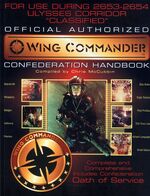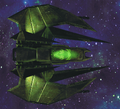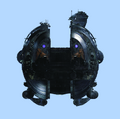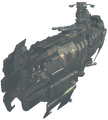Joan's Ships of Known Space (handbook)
| Joan's Fighting Spacecraft | |
|---|---|

| |
| Book | Wing Commander Confederation Handbook |
| Previous | War Hero Killed in Action |
| Next | SF Lt. Cmdr. Kien Chen's Death |
| Pages | 24-47 |
Text
Confederation Fighter
SCREEN 1
| query “joan’s ships of known space” level=UNCLASSIFIED
Joan's Ships of Known Space
The following data files are the property of Joan’s Interactive Data, Ltd. Every attempt has been made to insure the accuracy of the statistics and text, and where information is dubious, this has been noted.
CF-117b Rapier
Currently the primary utility fighter of the Confed space force, development on the Rapier began in 2527 and the first order of 700 was commissioned in 2536. The B model, with enhanced missile capacity and the more efficient rotary-barrel neutron gun, was phased in beginning in ’45, and the A model has been completely phased out. The Rapier has now largely supplanted the earlier CF-105 Scimitar, particularly in frontline operations. The Rapier combines acceleration, maneuverability and firepower to make it the premier one-on-one dogfighter in space today. Its handling superiority is necessary, since its short-range neutron guns require close approach to the enemy in combat.
The Rapier’s most distinguishing visual feature is its rotary-barrel neutron gun. The rotating multibarrel allows longer continuous neutron fire. The duel neutron pulse generators can be set to alternate or synchronous fire. Wing-mounted lasers provide longer-range fire support. It also mounts up to ten guided or dumbfire missiles.
The Rapier features the standard Confed Tempest targeting and navigational AI, and a jump-capable drive array. Its life-support systems are rated for up to seven hours cruise time. (A LARP variant exists, the 117b-L, with an enhanced sensor package and rated for up to 72 hours life support, but lacking the neutron gun.) The Rapier is not capable of sustained atmospheric operations—its wings function strictly as weapon/missile mounts. It can generate a retrieval tractor rated for up to 75 tonnes. It is capable of ejecting its pilot into a standard survival pod.
SCREEN 2
| subquery=“rapier” | sort=bestmatch | return=all source=joanships.mil.fgtr.ter.084956
| Class | Medium Fighter |
| Length | 9 meters |
| Mass | 9 tonnes |
| Cruise Velocity | 250 kps |
| Max Velocity | 450 kps |
| Weapons | Two Wing-Mounted Laser Cannon Duel-Pulse Rotary Barrel Neutron Gun (forward) 10 Missile Mounts |
| Armor | Fore and aft phase shields rated to 7 cm 5 cm fore armor/4 cm aft armor 3 cm port/starboard armor |
SCREEN 3
| query “joan’s ships of known space” level=UNCLASSIFIED
CF-131 Broadsword
The first Broadswords were deployed during the Pilgrim War to support Confed’s invasion fleet. It still remains Confed’s primary fighter/bomber. In 2648 all in-service Broadswords were upgraded to mount two antimatter torpedoes, but other than that change and minor upgrades to ship’s systems, the Broadsword of today remains remarkably similar to those that flew with the Grand Fleet.
The Broadsword stacks an amazing amount of destructive potential into a compact package, but only at the expense of maneuverability. The Broadsword has virtually no evasive capacity— it has to either destroy attackers outright or rely on escorts of lighter fighters. On the plus side, its three recessed turrets can provide a full 360 degrees of fire support, and be set for independent or synchronized targeting. There’s also a defensive AI mode that will automatically fire the turrets at any enemy targets of opportunity.
Like all Confed fighters, the Broadsword mounts a Tempest targeting and navigational system, and its drive array is jump-capable. The Broadsword is rated for up to 16 hours of life support. It can generate a retrieval tractor rated up to 150 tonnes. It is capable of ejecting the pilot in a standard survival pod.
SCREEN 4
| subquery=“broadsword” | sort=bestmatch | return=all source=joanships.mil.fgtr.ter.084956
| Class | Fighter/Bomber |
| Length | 12 meters |
| Mass | 14 tonnes |
| Cruise Velocity | 150 kps |
| Max Velocity | 320 kps |
| Weapons | 3 Mass-Driver Cannon (2 wing-mounted, one nose-mounted) 3 Missile Mounts 2 Torpedoes |
| Turrets | 3; 2 Neutron Guns in each |
| Armor | Fore and aft phase shields rated to 13 cm 10 cm fore/aft armor 8 cm port/starboard armor |
Kilrathi Fighter
SCREEN 5
| query “joan’s ships of known space” level=UNCLASSIFIED |
KF-100 Dralthi
There is anecdotal evidence that the Dralthi was the primary space fighter of all Kilrathi clans for as much as a century before first contact with humanity. Dralthi have been in the forefront of virtually every naval engagement of the present war. The utility fighter-ship of the Kilrathi arsenal, the lightly armed and armored Dralthi relies on its remarkable speed and maneuverability, plus effective group tactics, against superior Confed fighters like the Rapier.
From captured Dralthi, we know that the ship’s targeting systems are at least equal to the best Confed can offer, allowing Kilrathi pilots to take the best advantage of the ship’s limited offensive potential. Their life-support systems are capable of supporting a Kilrathi for about 10 hours (about four hours longer than an equivalent system could support a human, since Kilrathi physiology is better adapted to privation than a human’s). Its impulse engines are based on the same basic concepts of ram-scoop technology used by the interplanetary craft of humanity.
Dralthi are not jump-capable. They can generate a light tractor beam rated to about 5 tonnes, used primarily for salvage. Dralthi do not have an ejection system—Kilrathi warriors are expected to live or die along with their fighters.
SCREEN 6
| subquery=“dralthi” | sort=bestmatch | return=all source=joanships.mil.fgtr.kil.083952
| Class | Medium Fighter |
| Length | 9 meters |
| Mass | 10 tonnes |
| Cruise Velocity | 230 kps |
| Max Velocity | 400 kps |
| Weapons | 2 Laser Cannon (wing-mounted) 4 Missile Mounts |
| Armor | Fore and aft phase shields rated to 5 cm 4.5 cm fore armor/3.5 cm aft armor 3 cm port/starboard armor |
SCREEN 7
| query “joan’s ships of known space” level=UNCLASSIFIED |
KF-227 Salthi
This small, dangerously fast and maneuverable ship was seen more frequently in the early stages of the Terran/Kilrathi war. At present, it seems to be falling out of favor in the Empire, at least for front-line use. Intelligence suggests that the Salthi is still seeing a great deal of use deeper inside the Empire, for scouting and planetary defense.
A coordinated wing of four or more Salthi can represent a severe challenge to an opposing pilot, but their light defenses mean that even a single hit from most Confed fighters can take one out of action. Offensively, the Salthi’s inability to respond to a missile assault with equivalent power is a debilitating flaw.
Salthi possess sophisticated targeting routines equivalent to those of a Dralthi. They are not jump-capable, do not mount a tractor beam, and have no ejection system. A Salthi’s life-support system is capable of supporting a Kilrathi warrior for about 7 hours.
| Class | Light Fighter |
| Length | 6.5 meters |
| Mass | 12 tonnes |
| Cruise Velocity | 300 kps |
| Max Velocity | 480 kps |
| Weapons | 2 Laser Cannon 1 Missile Mount |
| Armor | Fore and aft phase shields rated to 3.5 cm 3 cm fore armor/2 cm aft armor 1.5 cm port/starboard armor |
register now
are you worthy?
VRsports
SCREEN 8
| subquery=“salthi” “krant” | sort=bestmatch | return=all source=joanships.mil.fgtr.kil.083952
Visit Worlds Away...
Right Next Door
The undisturbed worlds of Gemini Sector. The tour of a lifetime.
KF-402 Krant
The Krant seems to have predated the current conflict, but Intelligence believes that it was relatively little used, until it proved useful against Confed cap ships. The Krant is more heavily defended, but much less maneuverable, than the Dralthi. It appears to have been originally designed for cap-ship defense. When the development of meson shielding made capital ships effectively immune to conventional ship-to-ship missiles, the Kilrathi pressed the Krant into service as a dive-bomber, capable of delivering a pair of antimatter torpedoes to a meson-shielded target. In that capacity the Krant has become (along with long-range strategic missiles) the Kilrathi’s primary anti-cap-ship asset, a function which has currently nearly displaced their original purpose.
When configured for defensive operations the Krant deploys with four missiles and no torpedoes; when attacking an enemy cap ship it mounts torpedoes but no missiles. Krant bombers are virtually unique among Kilrathi pilots, in that they do not dogfight an enemy—they deliver their load to their target, and immediately return to their carrier to reload. (If possible. The Kilrathi have also been known to send Krant through jump points with one-use jump drives on suicide missions against Confed targets.)
Under normal mission conditions Krant are not jump-capable. They possess the same targeting and tractor systems as the Dralthi. Their lifesupport systems are capable of supporting a Kilrathi for about 15 hours. Like all Kilrathi ships, they possess no ejection system.
| Class | Medium Fighter/Bomber |
| Length | 11 meters |
| Mass | 11 tonnes |
| Cruise Velocity | 200 kps |
| Max Velocity | 360 kps |
| Weapons | 2 Laser Cannon (wing-mounted) 4 Missile or 2 Torpedo Mounts |
| Armor | Fore and aft phase shields rated to 6 cm 6 cm fore armor/6 cm aft armor 5 cm port/starboard armor |
Confederation Capital Ship
SCREEN 9
| query “joan’s ships of known space” level=UNCLASSIFIED
Concordia-Class Supercruiser
Currently the largest battleship in Confed’s fleet, the Concordia class was originally developed during the Pilgrim War. The original Concordia was named the Confed flagship in 2645 and serves as a mobile command center for Naval operations.
Defended by 30 point-defense missiles (for fighter defense) and 4 primary antimatter guns, the main offensive asset of the Concordia class is its 50 torpedo tubes, capable of launching both ship-to-ship and ship-to-planet munitions, including strategic weapons. It also mounts a small fighter deck capable of carrying a light squadron of about 20 medium fighters or fighter/bombers.
In keeping with its fleet command function, the Concordia class mounts enhanced longrange communications and sensor packages.
Standard protocol calls for a Concordia-class ship to travel in company with at least two destroyers and a cruiser (or larger battleship). Transports frequently convoy with a Concordia-class ship, since its fleet command function makes it a natural focus for ship tenders and other resupply operations.
The Concordia class takes 700 officers and crew, plus additional space for up to 350 working supercargo (command support and fleet operations personnel, plus a full hospital facility with a standing staff of 75). There’s additional space for up to 300 hospital patients and up to 60 prisoners in the brig, plus limited accommodations for noncrew passengers.
SCREEN 10
| subquery=“concordia” | sort=bestmatch | return=all source=joanships.mil.cap.ter.084956
| Length | 855 meters |
| Mass | 73,000 tonnes |
| Max Velocity | 100 kps |
| Cruise Velocity | 50 kps |
| Weapons | 30 Point-Defense 4 Antimatter Guns 50 Torpedo Tubes Light Fighter complement |
| Armor | Fore and aft meson shields 35 cm fore/aft armor 30 cm port/starboard armor |
SCREEN 11
| query “joan’s ships of known space” level=UNCLASSIFIED |
Bengal-Class Strike Carrier
The Bengal class has been Confed’s primary utility carrier since before the Pilgrim War (first commissioned in 2619). Development on a replacement carrier is ongoing, with a scheduled rollout no later than 2657, but for now the sturdy Bengal remains the mainstay of Confed’s fighter operations.
The Bengal class includes hangar space for up to 104 fighters or bombers— enough for one to four full squadrons (depending on the ship’s mission). Given reasonably experienced pilots and crew, a Bengal is capable of executing a full flush scramble (launching all 104 fighters) in as little as 12 minutes.
Modern Bengal-class ships carry enhanced map room imaging facilities for planning tactical operations. Crew capacity is 550 (including pilots and flight deck personnel), plus space for a marine complement of 50. In addition to full hangar and repair facilities for its fighters, a Bengal class can also carry and service corvettes and light transports with a cross-section of no more than 35 meters. In addition to its fighter complement, the Bengal class mounts eight turreted lasers for antifighter defense. Its torpedo tubes are primarily used for ship-to-ship munitions, but can be modified for strategic ship-to-planet devices.
SCREEN 12
| subquery=“bengal” | sort=bestmatch | return=all source=joanships.mil.cap.ter.084956
| Length | 625 meters |
| Mass | 55,000 tonnes |
| Cruise Velocity | 70 kps |
| Max Velocity | 130 kps |
| Weapons | 22 Point-Defense 8 Turreted Lasers 40 Torpedo Tubes Fighter complement |
| Armor | Fore and aft meson shields 24 cm fore armor/20 cm aft armor 25 cm port/starboard armor |
Kilrathi Capital Ship
SCREEN 13
| query “joan’s ships of known space” level=UNCLASSIFIED
Snakeir-Class Super-Dreadnought
The largest warship in the known Kilrathi arsenal, the Snakeir was first observed in battle in late 2649. It is believed to carry hangar capacity for at least 200 fighter craft. In addition to serving as a large carrier, its other purpose is to act as a space-to-planet missile platform, launching high-orbital and even interplanetary munitions on static targets. Recently, reports of long-range, self-guided shipkiller torpedoes being launched from Snakeirs at Confed warships have filtered through.
The capacity and capabilities of the Snakeir are highly speculative, as an intact specimen has never been taken in combat. Extrapolating from known design specs of earlier Kilrathi warships, it probably has a complement of officers and crew between 400 and 600 strong, plus additional space for up to 500 warriors, trained to serve both as pilots and as marines.
A Snakeir is usually accompanied by at least three destroyers or cruisers, with at least a dozen Krant escort fighters guarding the force at all times. It is often found escorting Kilrathi transports to the front.
51 individual Snakeirs have been reported engaged in operations on the front, of which four are known to have been destroyed in battle, and two believed lost to accident or mishap. All known Snakeirs have borne the markings of the imperial house, suggesting that the individual clans and worlds of the Empire do not sponsor Snakeir production, but that the Emperor has personally commissioned these ships for use in the Confed conflict.
Invest early.
Invest wisely.
Invest in life.
Galaxy Investment Group
SCREEN 14
| subquery=“snakeir” | sort=bestmatch | return=all source=joanships.mil.cap.kil.083952
| Length | 915 meters |
| Mass | 67,000 tonnes |
| Cruise Velocity | 100 kps |
| Max Velocity | 150 kps |
| Weapons | 42 Point-Defense 6 Turreted Lasers 14 Torpedo Tubes Fighter complement |
| Armor | Fore and aft meson shields 28 cm fore/24 cm aft armor 30 cm port/starboard armor |
Joan's Ships of Known Space
Remember—you saw it here first. Joan’s was the first civilian information organization to carry reports of the Snakeir. As soon as Joan’s learned of the discovery of this vessel, we had our data analysts combing transmissions for the statistical information you see above.
Joan’s Ships of Known Space Information you can count on.
SCREEN 15
| query “joan’s ships of known space” level=UNCLASSIFIED
Sivar-Class Dreadnought
The Sivar class is believed to predate the Terran/Kilrathi conflict. It is the premier main battle ship in the Kilrathi fleet, and a Sivar can be found at the heart of almost all Kilrathi task forces. More than 700 distinct Sivar-class vessels have been identified in action. It is the closest thing the Kilrathi have to a carrier in the Confed sense of the term, and carries hangar space for up to 150 fighters. Its missile capacity, by contrast, is rather limited, and is confined mostly to ship-to-ship torpedoes.
The Sivar class has exceptionally powerful impulse engines, making it the fastest large battleship currently in space. This speed, combined with its copious and efficient carrier capacity, provides its major strategic asset; the Sivar class can move quickly into position, launch a fighter strike on its objective, then move rapidly to a new assignment.
The Sivar class is believed to require a crew of 300, plus an additional 300 warriors for fighter and marine operations. The configuration and capacity of the Sivar class is quite well known, due to the fact that several have been captured largely intact over the years (most notably, an unarmed but otherwise completely functional ship taken in dry-dock early in the Epsilon initiative). Sivar-class warships have been observed with the markings of all the major noble clans, but increasingly they’re being disproportionately seen with imperial clan markings, indicating the ongoing centralization of strategic forces under the Emperor himself.
SCREEN 16
| subquery=“kilrathi dreadnought” | sort=bestmatch return=all | source=joanships.mil.cap.kil.083952
NEURAL MASSAGE Reduce your neurological cell stress levels by half in a single, ten-minute session.
220 cr/visit; First appointment free
| Length | 825 meters |
| Mass | 61,000 tonnes |
| Cruise Velocity | 100 kps |
| Max Velocity | 200 kps |
| Weapons | 23 Point-Defense 6 Turreted Lasers 12 Torpedo Tubes Fighter complement |
| Armor | Fore and aft meson shields 28 cm fore/18 cm aft armor 26 cm port/starboard armor |
SCREEN 17
| query “joan’s ships of known space” level=UNCLASSIFIED |
Thrakhra-Class ConCom
The newest addition to the Kilrathi fleet—it was first reliably reported in 2652—the Thrakhra class appears to represent a significant shift in Kilrathi strategic planning. The Thrakhra class is apparently a ship designed for the express purpose of fleet command and communications, with deliberately limited offensive capacity.
Only seven Thrakhra-class vessels have been authoritatively identified in action, and none has yet been destroyed or taken by Confed, so information about these ships is extremely tentative at this time.
Based on known crew complements of similar-sized vessels (the Fralthi-class cruiser), the Thrakhra class probably carries about 200 officers and crew. Confed intelligence theorizes that it also carries a very small contingent of warriors (probably 50 or less), but a large contingent of fleet support specialists, including strategists, intelligence analysts, and communications and sensor techs.
The Thrakhra class mounts only two laser turrets, and its fighter deck seems to be extremely small—probably including hangar capacity for around 12 ships, just enough to provide limited escort capacity. It does seem to carry a significant missile loadout, however, particularly of the ship-to-planet variety. It is theorized that this allows the Thrakhra class to complete cleanup operations after an objective is taken, freeing main battleships to take up defensive positions or pursue fleeing ships.
SCREEN 18
| subquery=“concom” | sort=bestmatch | return=all source=joanships.mil.cap.kil.083952
| Length | 490 meters |
| Mass | 27,000 tonnes |
| Cruise Velocity | 150 kps |
| Max Velocity | 200 kps |
| Weapons | 2 Turreted Lasers 10 Torpedo Tubes Light Fighter complement |
| Armor | Fore and aft meson shields 32 cm fore/20 cm aft armor 26 cm port/starboard armor |
SCREEN 19
| query “joan’s ships of known space” level=UNCLASSIFIED
Fralthi-Class Cruiser
The Fralthi class seems to have been the primary battleship for inter-clan civil war for at least a century before the Kilrathi encountered humanity. In its basic configuration it has probably seen service for 150 years or more. Almost 2000 individual Fralthi-class ships have been identified in action, and several have been taken intact. Almost all Kilrathi fleet actions will involve at least one, and probably several, Fralthi.
The smallest Kilrathi ship to mount a carrier deck, the Fralthi class is capable of carrying a light squadron of about 50 fighters. With its three antimatter main guns, it is very strong for its size in ship-to-ship actions, but carries a relatively small torpedo/missile loadout. It carries a complement of about 200 officers and crew, plus about 150 warriors.
Its engines are somewhat underpowered as compared to more recent Kilrathi ship designs, and it is both slow (in terms of top speed) and rather sluggish in its maneuvers. A Fralthi relies on its fighters and guns to repel an enemy, not on evasion or escape.
EXOTIC HOLO-BLOOMS
we deliver anywhere
ehb@01.888.233.7432
SCREEN 20
| subquery=“kilrathi cruiser” | sort=bestmatch | return=all source=joanships.mil.cap.kil.083952
| Length | 475 meters |
| Mass | 24,000 tonnes |
| Cruise Velocity | 100 kps |
| Max Velocity | 150 kps |
| Weapons | 18 Point-Defense 3 Antimatter Guns 8 Torpedo Tubes Fighter Complement |
| Armor | Fore and aft meson shields 28 cm fore armor 18 cm aft armor |
Joan’s has not yet acquired an accurate true-color image of a Fralthi-class cruiser. Our engineers have built the three-dimensional model below based on a synthesis of available intelligence.
SCREEN 21
| query “joan’s ships of known space” level=UNCLASSIFIED
Ralari-Class Destroyer
The Ralari-class destroyer represents the Kilrathi’s sole known attempt at a warship with no fighter complement. Ralari-class ships are used for fleet defense, planetary assault and orbital defense. They predate the current conflict, but from their engineering it is believed that they are a relatively recent innovation for the Kilrathi. A Ralari’s engines are extremely efficient, and it has above average speed and maneuverability for a ship its size. All Kilrathi task groups and escorted convoys include Ralari-class destroyers. Several thousand have been identified, and many intact specimens have been taken.
The Ralari holds a complement of about 150 officers and crew, plus a small unit of up to 50 warriors for use in marine operations. Although it doesn’t have a fighter deck, a Ralari’s standard complement includes three large transport shuttles, each capable of holding up to 100 armed warriors and their equipment. In invasion operations, they are often encountered in the presence of troop transports, with the Ralari acting as command and control for the landing operation.
The Ralari is also effective as a strategic bomber, and much of its cargo space is often devoted to ship-to-planet missile storage. Torpedoes, plus a remarkably heavy armament for a ship of its size, make it one of the most deadly Kilrathi vessels in ship-to-ship combat.
SCREEN 22
| subquery=“kilrathi destroyer” | sort=bestmatch | return=all source=joanships.mil.cap.kil.083952
| Length | 385 meters |
| Mass | 18,000 tonnes |
| Cruise Velocity | 150 kps |
| Max Velocity | 250 kps |
| Weapons | 2 Turreted Lasers 15 Point-Defense 2 Antimatter Guns 8 Torpedo Tubes |
| Armor | Fore and aft meson shields 25 cm fore/15 cm armor |
Merchant Vessel
SCREEN 23
| query “joan’s ships of known space” level=UNCLASSIFIED
Proxima Spaceworks Errant
The first Errants were produced in 2614, and the design has remained virtually unchanged since that time, aside from the addition of the optional-weapon hardpoints in 2621, incremental upgrades in the standard command and control software, and the evolution of the Hastings-Sakura drive array.
The lightest commercially available, jump-capable utility ship, the Proxima Errant is a workhorse of the Confed economy. The Errant is greatly valued for its modular construction and extreme customizability. Weapons and armor, for example, can be added and changed at will. The 10,000-cubic-meter hold can be fitted with a cabin module containing living space for one to four passengers (the unconfigured Errant includes cabin capacity for a crew of two, although only a single pilot is needed to operate the ship). By itself the Errant can be used effectively for light cargo, for passenger charter or as a courier, and it can even be customized for use as a recreational cabin cruiser. Its most common function, however, is as a control module for cargo drones or towed cargo units. Under its own power, an Errant has impulse capacity to effectively maneuver up to 20,000 tonnes of towed cargo. If its cargo units are independently powered, its capacity becomes effectively unlimited.
SCREEN 24
| subquery=“diligent, ?errant class” | sort=bestmatch return=all | source=joanships.mer.ter.074932
| Class | Merchantman |
| Length | 25 meters |
| Mass | 100 tonnes |
| Cruise Velocity | 100 kps |
| Max Velocity | 150 kps |
| Weapons | 2 forward hardpoints 1 turret hardpoint amidship |


















































